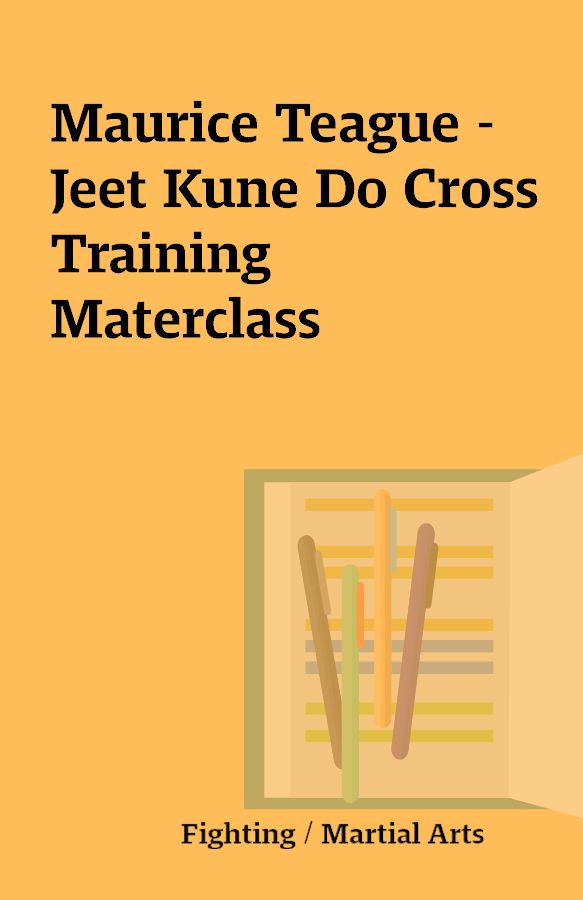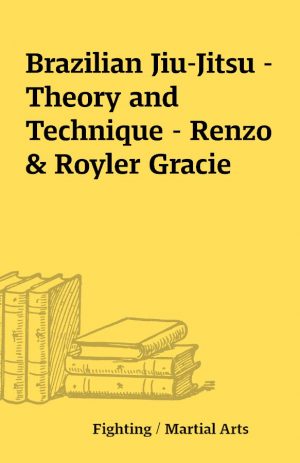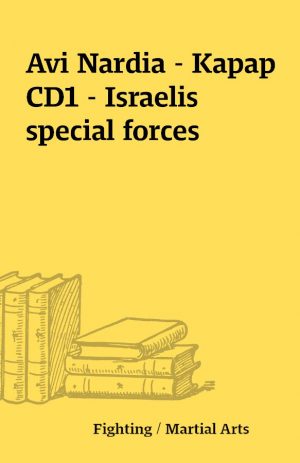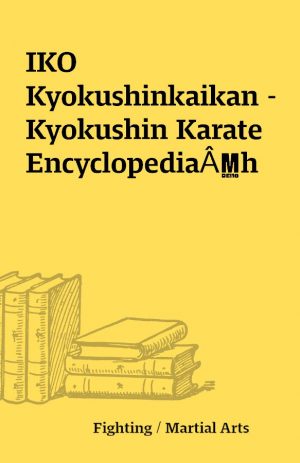Maurice Teague – Jeet Kune Do Cross Training Materclass
Maurice Teague – Jeet Kune Do Cross Training Materclass [DVD rip (avi)]
[DVD rip (avi)]
Description
previous product was asked to be reseeded. I reseeded the file but it could not be downloaded. I am uploading this file as a new product in hopes that people will be able to download the new file. For more information see the GB thread here TEAGUEMaurice ‘Mo’ Teague is a Coach within the BCA and has probably the most practical, real life experience of anyone in the Association. He has a very impressive, practical background that few people could aspire to.He started in martial arts more than 27 years ago in traditional Shotokan Karate and has since trained in Wing Chun, Tai Chi, Muay Thai, Boxing, Sambo, Judo, Eskrima and JKD. He is an Instructor under Grand Master Richard Bustillo of the IMB Academy in Los Angeles, California and also an Instructor under Rick Faye. Mo spent 15 years in an Infranty Regiment, seeing active service in Northern Ireland, including Covert Ops, and front-line service in the Gulf War. During this period and amongst other things, Mo was a weapons and tactics instructor, an arrest and restraint instructor and a search advisor (IEDs). Mo’s practical experience of ‘Street’ engagements comes from over 10 years of door work, during which period he worked for 2 years on his own in a bikers bar. He has worked as a Bodyguard and was a member of the U.K. chapter of the Guardian Angels. With over 300 street confrontations, which have included knife attacks, Mo’s experience is second to none.This seminar was filmed on our April 2005 BCA seminar. Mo spends time on his ‘SSTTM’ Model -a confrontational Map and ‘Physical Options’ system to help people survive violent confrontations.”Mo” Teague started martial arts training over thirty years ago, and has trained in Karate, Judo, Boxing, Sambo, Brazilian Ju-Jitsu, Muay Thai, Silat, Wing Chun, Tai Chi and Jeet-Kune-Do.He served for fifteen years in an elite british army infantry regiment, seeing active service four times. Member of covert surveillance unit, also a member of The Guardian Angels.Worked as a bodyguard.Was a bouncer for over ten years having over 300 street fights.Now training bouncers and bodyguards.Teaches Special Forces and law enforcement agencies.JEET KUNE DOJeet Kune Do (Chinese: 截拳道, Cantonese: Jitkyùndou, Jyutping: Zit6 Kyun4 Do6, Pinyin: Jiéquándào lit. “Way of the Intercepting Fist,” also “Jeet Kun Do”,”JKD,” or “Jeet Kuen Do”) is a hybrid martial arts system and life philosophy founded by Bruce Lee in 1967 with direct, non classical and straightforward movements. Jeet Kune Do is primarily an open hand system. The system works on the use of different ‘tools’ for different situations. These situations are broken down into ranges (Kicking, Punching, Trapping and Grappling), with techniques flowing smoothly between them. Also, it is referred to as a “style without style”. Unlike more traditional martial arts, Jeet Kune Do is not fixed or patterned, and is a philosophy with guiding thoughts.In 2004, the Bruce Lee Foundation decided to use the name Jun Fan Jeet Kune Do (振藩截拳道) to refer to the martial arts system that Lee founded. “Jun Fan” was Lee’s Chinese given name, so the literal translation is “Bruce Lee’s Way of the Intercepting Fist.”System and philosophyLee’s philosophyJeet Kune Do (JKD) is the name Bruce Lee gave to his combat system and philosophy in 1967. Originally, when Lee began researching various fighting styles, he gave his martial art his own name of Jun Fan Gung Fu. However not wanting to create another style that would share the limitations that all styles have, he instead gave us the process that created it.Bruce Lee said:I have not invented a “new style,” composite, modified or otherwise that is set within distinct form as apart from “this” method or “that” method. On the contrary, I hope to free my followers from clinging to styles, patterns, or molds. Remember that Jeet Kune Do is merely a name used, a mirror in which to see “ourselves”. . . Jeet Kune Do is not an organized institution that one can be a member of. Either you understand or you don’t, and that is that. There is no mystery about my style. My movements are simple, direct and non-classical. The extraordinary part of it lies in its simplicity. Every movement in Jeet Kune-Do is being so of itself. There is nothing artificial about it. I always believe that the easy way is the right way. Jeet Kune-Do is simply the direct expression of one’s feelings with the minimum of movements and energy. The closer to the true way of Kung Fu, the less wastage of expression there is. Finally, a Jeet Kune Do man who says Jeet Kune Do is exclusively Jeet Kune Do is simply not with it. He is still hung up on his self-closing resistance, in this case anchored down to reactionary pattern, and naturally is still bound by another modified pattern and can move within its limits. He has not digested the simple fact that truth exists outside all molds; pattern and awareness is never exclusive. Again let me remind you Jeet Kune Do is just a name used, a boat to get one across, and once across it is to be discarded and not to be carried on one’s back.– Bruce LeeModern Jeet Kune Do philosophyJKD as it survives today — if one wants to view it “refined” as a product, not a process — is what was left at the time of Bruce Lee’s death. It is the result of the life-long martial arts development process Lee went through. Bruce Lee stated that his concept is not an “adding to” of more and more things on top of each other to form a system, but rather, a winnowing out. The metaphor Lee borrowed from Chan Buddhism was of constantly filling a cup with water, and then emptying it, used for describing Lee’s philosophy of “casting off what is useless”. He also used the sculptor’s mentality of beginning with a lump of clay and hacking away at the “unessentials”; the end result was what he considered to be the bare combat essentials, or JKD.The core concepts of JKD are derived from Wing Chun. This includes such ideas as centerline control, vertical punching, trapping, and forward pressure. Through his personal research and readings, Lee also incorporated ideas from boxing and fencing. Later during the development of Jeet Kune Do, he would expand to include the art for personal development, not just to become a better fighter. To illustrate Lee’s views, in a 1971 Black Belt Magazine article, Lee said “Let it be understood once and for all that I have NOT invented a new style, composite or modification. I have in no way set Jeet Kune Do within a distinct form governed by laws that distinguish it from ‘this’ style or ‘that’ method. On the contrary, I hope to free my comrades from bondage to styles, patterns and doctrines.”One of the theories of JKD is that a fighter should do whatever is necessary to defend himself, regardless of where the techniques come from. One of Lee’s goals in Jeet Kune Do was to break down what he claimed were limiting factors in traditional martial arts training, and seek a fighting thesis which he believed could only be found within the reality of a fight. Jeet Kune Do is currently seen as the genesis of the modern state of hybrid martial arts.Jeet Kune Do not only advocates the combination of aspects of different styles, it also can change many of those aspects that it adopts to suit the abilities of the practitioner. Additionally, JKD advocates that any practitioner be allowed to interpret techniques for themselves, and change them for their own purposes. For example, Lee almost always chose to put his power hand in the “lead,” with his weaker hand back, within this stance he used elements of Boxing, Fencing and Wing Chun. Just like fencing, he labeled this position the “On Guard” position. Lee incorporated this position into his JKD as he felt it provided the best overall mobility. He felt that the dominant or strongest hand should be in the lead because it would perform a greater percentage of the work. Lee minimized the use of other stances except when circumstances warranted such actions. Although the On-Guard position is a good overall stance, it is by no means the only one. He acknowledged that there were times when other positions should be utilized.Lee felt the dynamic property of JKD was what enabled its practitioners to adapt to the constant changes and fluctuations of live combat. He believed that these decisions should be done within the context of “real combat” and/or “all out sparring” and that it was only in this environment that a person could actually deem a technique worthy of adoption.Bruce Lee did not stress the memorization of solo training forms or “Kata”, as most traditional styles do in their beginning-level training. He often compared doing forms without an opponent to attempting to learn to swim on dry land. Lee believed that real combat was alive and dynamic. Circumstances in a fight change from millisecond to millisecond, and thus pre-arranged patterns and techniques are not adequate in dealing with such a changing situation. As an anecdote to this thinking, Lee once wrote an epitaph which read: ‘In memory of a once fluid man, crammed and distorted by the classical mess.’ The “classical mess” in this instance was what Lee thought of classical martial arts.Bruce Lee’s comments and methods were seen as controversial by many in his time, and still are today. Many teachers from traditional schools disagreed with his opinions on these issues.The notion of cross-training in Jeet Kune Do is similar to the practice of Mixed Martial Arts (MMA). Many consider Jeet Kune Do to be the precursor of MMA because of its syncretic nature. This is particularly the case with respect to the JKD “Combat Ranges”. A JKD student is expected to learn various combat systems within each combat range, and thus to be effective in all of them.PrinciplesThe following are principles that Lee incorporated into Jeet Kune Do. He felt these were universal combat truths that were self evident and would lead to combat success if followed. The “4 Combat Ranges” in particular are what he felt were instrumental in becoming a “total” martial artist. This is also the principle most related to mixed martial arts.JKD practitioners also subscribe to the notion that the best defense is a strong offense, hence the principle of “Intercepting”. Lee believed that in order for an opponent to attack someone they had to move towards them. This provided an opportunity to “intercept” that attack or movement. The principle of interception covers more than just intercepting physical attacks. Lee believed that many non-verbals and telegraphs (subtle movements that an opponent is unaware of) could be perceived or “intercepted” and thus be used to one’s advantage. The “5 Ways of Attack” are attacking categories that help Jeet Kune Do practitioners organize their fighting repertoire and comprise the offensive portion of JKD. The concepts of Stop hits & stop kicks and simultaneous parrying & punching were borrowed from European Fencing and Wing Chun’s theory of simultaneous defending and attacking, and comprise the defensive portion of JKD. These concepts were modified for unarmed combat and implemented into the JKD framework by Lee. These concepts also complement the other principle of interception.Be like waterLee believed that martial systems should be as flexible as possible. He often used water as an analogy for describing why flexibility is a desired trait in martial arts. Water is infinitely flexible. It can be seen through, and yet at other times it can obscure things from sight. It can split and go around things, rejoining on the other side, or it can crash through things. It can erode the hardest rocks by gently lapping away at them or it can flow past the tiniest pebble. Lee believed that a martial system should have these attributes. JKD students reject traditional systems of training, fighting styles and the Confucian pedagogy used in traditional kung fu schools because of this lack of flexibility. JKD is claimed to be a dynamic concept that is forever changing, thus being extremely flexible. “Absorb what is useful; Disregard that which is useless” is an often quoted Bruce Lee maxim. JKD students are encouraged to study every form of combat possible. This is believed to expand one’s knowledge of other fighting systems; to both add to one’s arsenal as well as to know how to defend against such tactics.Economy of motionJKD students are told to waste no time or movement. When it comes to combat JKD practitioners believe the simplest things work best. Economy of motion is the principle by which JKD practitioners achieve “efficiency” describe in the three parts of JKD. Utilizing this principle conserves both energy and time. Energy and time are two crucial components in a physical confrontation that often leads to success if employed efficiently. In combat situations maximizing one’s energy is beneficial in maintaining physical activity. Likewise minimizing the time to execute techniques because of traveling less distance is beneficial in that the opponent has less time to react.Stop hits & stop kicksThis means intercepting an opponent’s attack with an attack of your own instead of a simple block. JKD practitioners believe that this is the most difficult defensive skill to develop. This strategy is a feature of some traditional Chinese martial arts, as well as an essential component of European épée fencing. Stop hits & kicks utilize the principle of economy of motion by combining attack and defense into one movement thus minimizing the “time” element.Simultaneous parrying & punchingWhen confronting an incoming attack, the attack is parried or deflected and a counter attack is delivered at the same time. Not as advanced as a stop hit but more effective than blocking and counter attacking in sequence. This is also practiced by some Chinese martial arts. Simultaneous parrying & punching utilizes the principle of economy of motion by combining attack and defense into two movements thus minimizing the “time” element and maximizing the “energy” element. Efficiency is gained by utilizing a parry rather than a block. By definition a “block” stops an attack whereas a parry merely re-directs an attack. Redirection has two advantages: It requires less energy to execute. It utilizes the opponents energy against them by creating an imbalance. Efficiency is also gained in that the opponent has less time to react to the nullification of their attack while having to worry about defending an incoming attack.High kicksJKD practitioners believe they should target their kicks to their opponent’s shins, knees, thighs, and mid section. These targets are the closest to the foot, provide more stability and are more difficult to defend against. However, as with all other JKD principles nothing is “written in stone”. If a target of opportunity presents itself, even a target above the waist, one could take advantage of the situation without feeling hampered by this principle. Maintaining low kicks utilizes the principle of economy of motion by reducing the distance a kick must travel thus minimizing the “time” element. Low kicks are also more difficult to detect and thus guard against.The four ranges of combatKickingPunchingTrappingGrapplingJeet Kune Do students train in each of these ranges equally. According to Lee, this range of training serves to differentiate JKD from other martial arts. Lee stated that most but not all traditional martial systems specialize in training at one or two ranges. Bruce Lee’s theories have been especially influential and substantiated in the field of Mixed Martial Arts, as the MMA Phases of Combat are essentially the same concept as the JKD combat ranges. As a historical note, the ranges in JKD have evolved over time. Initially the ranges were categorized as short or close, medium, and long range.[4] These terms proved ambiguous and eventually evolved into their more descriptive forms although there may still be others who prefer the three categories.Five Ways Of AttackSingle Angle Attack (SAA)/Single Direct Attack (SDA).Is a single motion (Punch or Kick) which moves with no effort to conceal it, directly to the target on the most economical route. It can also be indirect, beginning on one line and ending on another. Such as a punch that starts to the stomach (mid line) and ends on the chin (high line). SAA is an attack that is launched from an unanticipated angle that is achieved by moving in such a way as to create an open line into which to strikeHand Immobilization Attack (HIA) and its counterpart Foot Immobilization attack, which make use of trapping/parrying to limit the opponent’s function with that appendage.Progressive Indirect Attack (PIA). Simulating an attack to one part of the opponent’s body followed by attacking another part as a means of creating an opening.Attack By Combinations (ABC). This is using multiple rapid attacks, with volume of attack as a means of overcoming the opponent.[6]Attack By Drawing (ABD). The goal when using attack by draw is to “draw” the opponent into a committed attack by baiting him into what looks like an exposed target, then intercepting his/her motion. One can execute a motion that invites a counter, then counter attack them as he takes the bait.[7][edit] Three Parts of JKDJKD practitioners believe that techniques should contain the following properties:Efficiency – An attack that reaches its mark using the maximum amount of energy and applying it to a single point in the least amount of time.Directness – Doing what comes naturally in a learned way.Simplicity – Thinking in an uncomplicated manner; without ornamentation.CenterlineThe centerline refers to an imaginary line running down the center of one’s body. The theory is to exploit, control and dominate your opponent’s centerline. All attacks, defenses and footwork are designed to preserve your own centerline and open your opponent’s. Lee incorporated this theory into JKD from Wing Chun. This notion is closely related to maintaining control of the center squares in the strategic game chess.The three guidelines for centerline are:The one who controls the centerline will control the fight.Protect and maintain your own centerline while you control and exploit your opponent’s.Control the centerline by occupying it.Combat realismOne of the premises that Bruce Lee incorporated in Jeet Kune do was “combat realism”. He insisted that martial arts techniques should be incorporated based upon its effectiveness in real combat situations. This would differentiate JKD from other systems where there was an emphasis on “flowery technique” as Lee would put it. Lee claimed that flashy “flowery techniques” would arguably “look good” but were often not practical or prove ineffective in street survival and self-defense situations. This premise would also differentiate JKD from other “sport” oriented martial arts systems that where geared towards “tournament” or “point systems”. Lee felt that these systems were “artificial” and fooled its practitioners into a false sense of true martial skill. Lee felt that because these systems favored a “sports” approach they incorporated too many rule sets that would ultimately handicap a practitioner in self defense situations. He also felt that this approach to martial arts became a “game of tag” which would lead to bad habits such as pulling punches and other attacks; this would again lead to disastrous consequences in real world situations. Because of this perspective Lee utilized safety gear from various other contact sports to allow him to spar with opponents “full out”. This approach to training allowed practitioners to come as close as possible to real combat situations with a high degree of safety. Donn Draeger world renown martial arts pioneer was the first Westerner to bring widespread attention to the often cited “-do” versus “-jutsu” controversy. Historically the “do” or way arts were based on the “jutsu” or technique arts without what was deemed “dangerous techniques”. The “do” arts such as Judo were thus seen as a “watered down” version of their “jutsu” counterparts such as Ju-Jutsu, a combat-tested martial art, and thus considered a sport. Lee objected to these “sport” versions of martial arts and instead emphasized combat realism.Absorbing what is usefulThis is the idea that one can only learn techniques in their proper context only through a holistic approach. styles provide more than just techniques; they also offer training methods, theories, and mental attitudes. Learning all of these factors allows a student to experience a system in what Lee called its “totality”. It is only through its totality that one can “absorb what is useful”. Applying what is learned in real combat training situations is what allows the student to figure what works or doesn’t work for oneself. It is at this point that one can discard that which is useless. The critical point of this principle is that the choice of what to keep is based on personal experimentation with various opponents over time. It is not based on how a technique may look or feel or how well one can execute it. In the final analysis if the technique is not beneficial in combat it is discarded. Lee believed that only the individual could come to understand what worked for oneself based on critical self analysis and by “honestly expressing oneself; without lying to oneself”.Enjoy!!!
You must be logged in to post a review.






Reviews
There are no reviews yet.